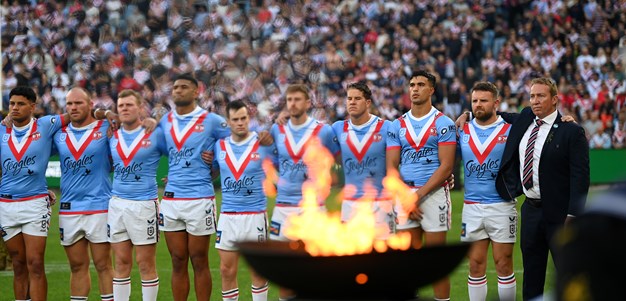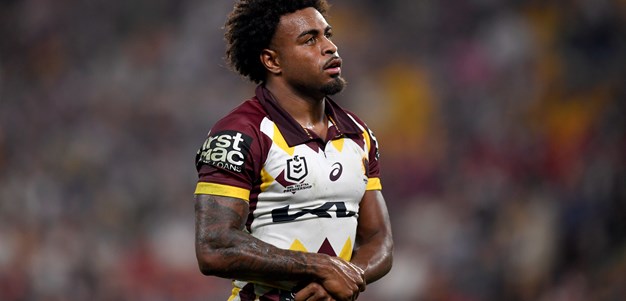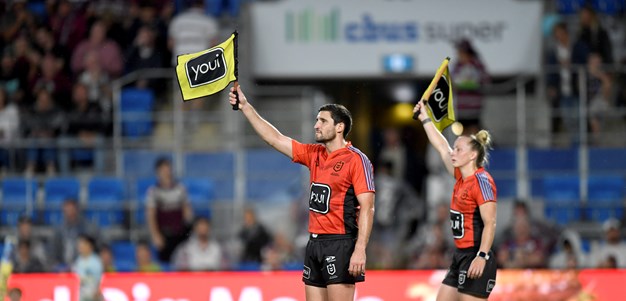Regular Season
WINS: 12
LOSSES: 11
DRAWS: 1
POSITION: 8th
HOME RECORD: 7 wins, 4 losses, 1 draw (=8th)
AWAY RECORD: 5 wins, 7 losses (=6th)
After Finals
FINALS RECORD: 3-1 (Won 25-12 v Dragons; Won 27-2 v Titans, Won 22-12 v Bulldogs, Lost 23-16 v Storm to finish runners-up)
BEST WINNING STREAK: 7 (rounds 19-25)
LONGEST LOSING STREAK: 4 (rounds 4-7)
PLAYERS USED: 28 (5 debutants)
PLAYER OF THE YEAR: Jarryd Hayne
TRIES SCORED (After 26 rounds): 83 (12th most)
TRIES CONCEDED (After 26 rounds): 82 (4th fewest)
Never has a season found two such starkly different peaks and troughs in recent memory than the Eels’ in 2009. They started the season, in coach Daniel Anderson’s words, as a “rabble” and finished it as the centerpiece of Sydney’s sporting landscape.
The turnaround was remarkable – fumbling, lackluster play was replaced by exciting team tries and amazing feats of individual brilliance. Uncommitted and lazy defence transformed into an impenetrable wall, brimming with the confidence to keep teams out.
Gaining confidence was the biggest hurdle for the Eels after their disappointing start to the year. But once they did, they embarked on a seven-match winning streak that led them straight to the finals. And once there, Parramatta barely skipped a beat, refusing to play ‘safe’ football throughout the playoffs.
Then came Grand Final day… and the momentum stopped. The rookie enthusiasm which breathed life into their season was overawed by Melbourne’s experience; but there is no doubt what we witnessed in 2009 could just be the entrée for next season’s main course.
Where They Excelled… The ability for this team to offload was staggering. Their capacity to keep the ball alive is what led to some of the best tries this season, including their Round 24 effort against the Wests Tigers, voted the best team try of the season.
Three players were in the top 10 offloaders of the season – Nathan Hindmarsh, Feleti Mateo (both with 52) and Krisnan Inu (51).
By the end of the season their average was 17.6 offloads a game – three more than any other team. But it was their ability to make them stick that was so effective. They averaged just 11.6 errors a game, equal fifth-best in the NRL.
Where They Struggled… The opening rounds of the season. They were inconsistent and there was no flow or structure to their attack. But the real problem was their defence – at one point they conceded 88 points in just two weeks!
The Eels were leaking points at an alarming rate, and struggling to score any in return, conceding 184 points in the first seven rounds of the comp and scoring just 90.
Missing In Action… It did not take long for coach Daniel Anderson to decide Brett Finch was not the answer for the Eels at halfback – and told him so just four weeks into the season. It prompted Finch’s early departure from the club, and quickly promoted young Kris Keating into the playmaker’s role.
Forward Josh Cordoba was another to leave the club mid-year, but the Eels were able to comfortably replace him. Last year’s Rookie of the Year Taulima Tautai played just eight games and failed to impress, scoring one try.
Turning Point… Many will hang the turnaround in the Eels’ fortunes on Nathan Hindmarsh’s 250th game – the Round 19 win over the Melbourne Storm. However the real turning point came earlier – in Round 13 Parramatta lost to the Sharks to end Cronulla’s nine-game losing streak. It was a terrible performance, and Anderson pulled his players together after that loss to overhaul their attitude.
They traveled to Newcastle the following week, and in just his second first grade game, Daniel Mortimer starred to help the Eels to a two-point win. The consistency was still not there, losing again the next week, but performances were improving.
The week before the Storm game Parramatta played well against the Titans but came up just short. For those watching closely though, they could see a shift in Parramatta that became an unstoppable force in the following weeks.
Best Games… The Eels gave us a glimpse of what was to come in their Round 20 win over the Bulldogs. Their defence had stiffened up and they were scoring classy tries.
What followed was three weeks of shut-outs – in succession the Eels thrashed Cronulla, Newcastle and the Warriors, before defeating the Tigers in a thriller, and then demolished Penrith. Those wins were outstanding, with the Eels dominant in both attack and defence.
However, the real standout performance came when they needed it – in the Preliminary Final against the Bulldogs. In front of a 75,000-strong crowd, the Eels put on a show, with tries to Mortimer and Tim Mannah again demonstrating the attacking and offloading prowess of the side.
Worst Games… The loss to the Sharks must rank as the worst of the season. At home against a weakened opposition Parramatta were expected to win. But in a scrappy match the Sharks outplayed the Eels, who were seriously ill-disciplined.
Two weeks later the Eels put in an inept performance against the Wests Tigers, losing 23-6 in another game they should have won. Earlier in the year they lost to eventual wooden spooners the Roosters 24-6, then the Dragons, and in successive weeks lost to the Bulldogs 48-18, and Brisbane 40-8.
Anyone who saw those performances would not believe that team ended up in the Grand Final, but it is an indication of just how far they came.
Hold Your Head High… He was the Dally M Medal winner, topped the line breaks for the year (32), and was the force behind the Eels’ late-season surge, but Jarryd Hayne was not the only player in this side.
Every member was at their best at times. Nathan Hindmarsh got back in touch with his attacking skills, while still managing to maintain an average of 45 tackles a game. “Anonymous” players before this year, like Jeff Robson, Todd Lowrie and Kevin Kingston, produced their best to keep up with the likes of Hayne and Fuifui Moimoi (120 metres, 16 tackles from just an average 43 minutes), who finished the year as possibly the best prop in the game. Rookie Daniel Mortimer (61 tackle breaks, seven try assists and 12 line breaks – including three in the decider) was a revelation in the halves, while Matt Keating at hooker was consistently solid.
Coach Daniel Anderson says… “We’ve played in October, and to play in October is an achievement. It’s difficult and it’s disappointing now, but we need to be very comfortable with our contribution to rugby league.
“Western Sydney captured the attention of a lot of neutral fans, and the blue-and-gold army. It’s a start. We need to win a competition to progress but they’re probably bigger steps than I thought we’d take in my first year.”
Conclusion… They surprised everyone – even themselves – when they qualified for the Grand Final. But even though Parramatta stumbled at the final step it was still a successful year. The fans returned in droves and the Eels played rugby league everyone enjoyed.
Their defence rediscovered the edge that made the club successful in the late 1990s, and a new wave of stars emerged.
Watch out in 2010.
WINS: 12
LOSSES: 11
DRAWS: 1
POSITION: 8th
HOME RECORD: 7 wins, 4 losses, 1 draw (=8th)
AWAY RECORD: 5 wins, 7 losses (=6th)
After Finals
FINALS RECORD: 3-1 (Won 25-12 v Dragons; Won 27-2 v Titans, Won 22-12 v Bulldogs, Lost 23-16 v Storm to finish runners-up)
BEST WINNING STREAK: 7 (rounds 19-25)
LONGEST LOSING STREAK: 4 (rounds 4-7)
PLAYERS USED: 28 (5 debutants)
PLAYER OF THE YEAR: Jarryd Hayne
TRIES SCORED (After 26 rounds): 83 (12th most)
TRIES CONCEDED (After 26 rounds): 82 (4th fewest)
Never has a season found two such starkly different peaks and troughs in recent memory than the Eels’ in 2009. They started the season, in coach Daniel Anderson’s words, as a “rabble” and finished it as the centerpiece of Sydney’s sporting landscape.
The turnaround was remarkable – fumbling, lackluster play was replaced by exciting team tries and amazing feats of individual brilliance. Uncommitted and lazy defence transformed into an impenetrable wall, brimming with the confidence to keep teams out.
Gaining confidence was the biggest hurdle for the Eels after their disappointing start to the year. But once they did, they embarked on a seven-match winning streak that led them straight to the finals. And once there, Parramatta barely skipped a beat, refusing to play ‘safe’ football throughout the playoffs.
Then came Grand Final day… and the momentum stopped. The rookie enthusiasm which breathed life into their season was overawed by Melbourne’s experience; but there is no doubt what we witnessed in 2009 could just be the entrée for next season’s main course.
Where They Excelled… The ability for this team to offload was staggering. Their capacity to keep the ball alive is what led to some of the best tries this season, including their Round 24 effort against the Wests Tigers, voted the best team try of the season.
Three players were in the top 10 offloaders of the season – Nathan Hindmarsh, Feleti Mateo (both with 52) and Krisnan Inu (51).
By the end of the season their average was 17.6 offloads a game – three more than any other team. But it was their ability to make them stick that was so effective. They averaged just 11.6 errors a game, equal fifth-best in the NRL.
Where They Struggled… The opening rounds of the season. They were inconsistent and there was no flow or structure to their attack. But the real problem was their defence – at one point they conceded 88 points in just two weeks!
The Eels were leaking points at an alarming rate, and struggling to score any in return, conceding 184 points in the first seven rounds of the comp and scoring just 90.
Missing In Action… It did not take long for coach Daniel Anderson to decide Brett Finch was not the answer for the Eels at halfback – and told him so just four weeks into the season. It prompted Finch’s early departure from the club, and quickly promoted young Kris Keating into the playmaker’s role.
Forward Josh Cordoba was another to leave the club mid-year, but the Eels were able to comfortably replace him. Last year’s Rookie of the Year Taulima Tautai played just eight games and failed to impress, scoring one try.
Turning Point… Many will hang the turnaround in the Eels’ fortunes on Nathan Hindmarsh’s 250th game – the Round 19 win over the Melbourne Storm. However the real turning point came earlier – in Round 13 Parramatta lost to the Sharks to end Cronulla’s nine-game losing streak. It was a terrible performance, and Anderson pulled his players together after that loss to overhaul their attitude.
They traveled to Newcastle the following week, and in just his second first grade game, Daniel Mortimer starred to help the Eels to a two-point win. The consistency was still not there, losing again the next week, but performances were improving.
The week before the Storm game Parramatta played well against the Titans but came up just short. For those watching closely though, they could see a shift in Parramatta that became an unstoppable force in the following weeks.
Best Games… The Eels gave us a glimpse of what was to come in their Round 20 win over the Bulldogs. Their defence had stiffened up and they were scoring classy tries.
What followed was three weeks of shut-outs – in succession the Eels thrashed Cronulla, Newcastle and the Warriors, before defeating the Tigers in a thriller, and then demolished Penrith. Those wins were outstanding, with the Eels dominant in both attack and defence.
However, the real standout performance came when they needed it – in the Preliminary Final against the Bulldogs. In front of a 75,000-strong crowd, the Eels put on a show, with tries to Mortimer and Tim Mannah again demonstrating the attacking and offloading prowess of the side.
Worst Games… The loss to the Sharks must rank as the worst of the season. At home against a weakened opposition Parramatta were expected to win. But in a scrappy match the Sharks outplayed the Eels, who were seriously ill-disciplined.
Two weeks later the Eels put in an inept performance against the Wests Tigers, losing 23-6 in another game they should have won. Earlier in the year they lost to eventual wooden spooners the Roosters 24-6, then the Dragons, and in successive weeks lost to the Bulldogs 48-18, and Brisbane 40-8.
Anyone who saw those performances would not believe that team ended up in the Grand Final, but it is an indication of just how far they came.
Hold Your Head High… He was the Dally M Medal winner, topped the line breaks for the year (32), and was the force behind the Eels’ late-season surge, but Jarryd Hayne was not the only player in this side.
Every member was at their best at times. Nathan Hindmarsh got back in touch with his attacking skills, while still managing to maintain an average of 45 tackles a game. “Anonymous” players before this year, like Jeff Robson, Todd Lowrie and Kevin Kingston, produced their best to keep up with the likes of Hayne and Fuifui Moimoi (120 metres, 16 tackles from just an average 43 minutes), who finished the year as possibly the best prop in the game. Rookie Daniel Mortimer (61 tackle breaks, seven try assists and 12 line breaks – including three in the decider) was a revelation in the halves, while Matt Keating at hooker was consistently solid.
Coach Daniel Anderson says… “We’ve played in October, and to play in October is an achievement. It’s difficult and it’s disappointing now, but we need to be very comfortable with our contribution to rugby league.
“Western Sydney captured the attention of a lot of neutral fans, and the blue-and-gold army. It’s a start. We need to win a competition to progress but they’re probably bigger steps than I thought we’d take in my first year.”
Conclusion… They surprised everyone – even themselves – when they qualified for the Grand Final. But even though Parramatta stumbled at the final step it was still a successful year. The fans returned in droves and the Eels played rugby league everyone enjoyed.
Their defence rediscovered the edge that made the club successful in the late 1990s, and a new wave of stars emerged.
Watch out in 2010.



